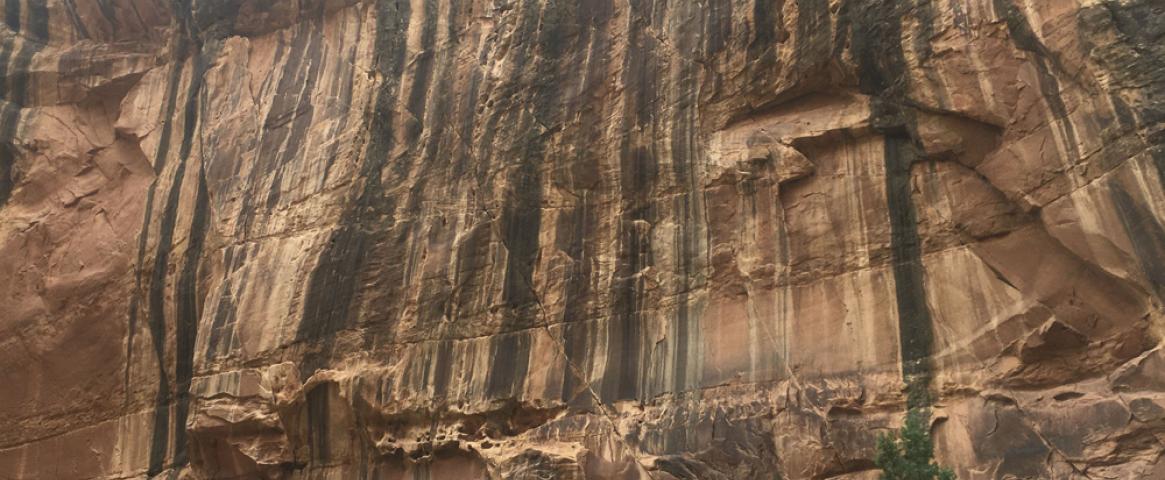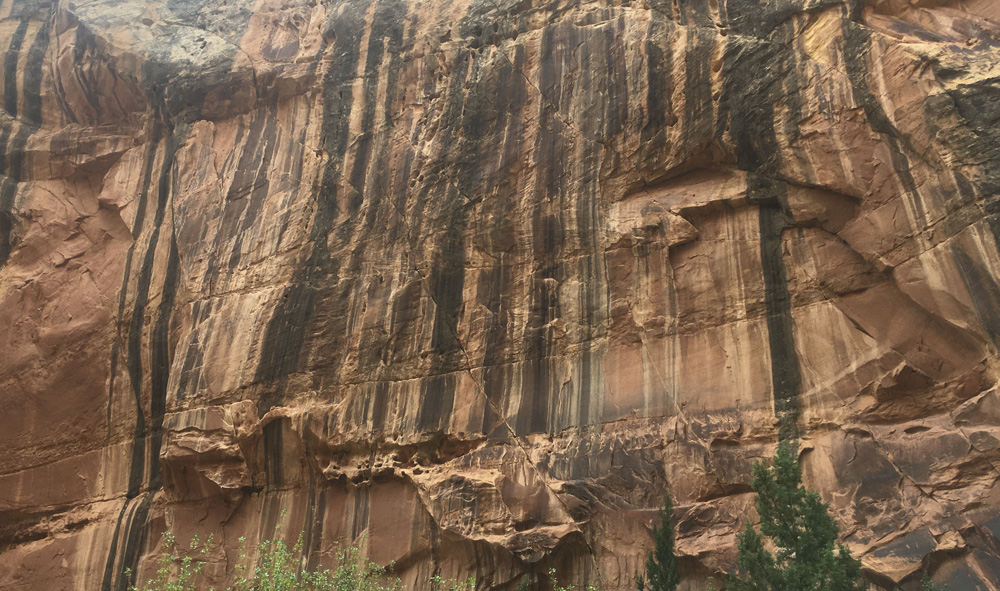By Caitlin Shirts
Hikers in the desert sometimes take pictures of dark stripes on cliffs then feed them into barcode readers to see if, by coincidence, a pattern brings up a can of soup or some other product. (They never do.) The colors come from a coating, called rock varnish or desert varnish, filled with iron and manganese. The high level of manganese may be a clue that varnish begins with bacteria that make their own sunscreen from the metal, according to a recent study published in PNAS.
Under stripes and patches of varnish around the world, rocks are alive with bacteria. Since the coating can take centuries to become visible, scientists can’t observe whether the bacteria make it themselves or settle under it to take advantage of the shade.
Varnish-like coatings full of manganese have even been found on Mars. If varnish does form through bacteria, that raises questions about Martian life.
“There is so much more manganese in varnish, a hundred times higher concentration of manganese in varnish than in any of the other materials around,” said Usha F. Lingappa, first author on the paper who recently earned a doctorate in geobiology at Caltech. “The longstanding mystery has been what possible process can leave so much manganese concentrated without concentrating the other similar elements?”
Lingappa and her colleagues brought in technology to look at varnish from fresh angles. Nanoscale secondary ion mass spectrometry and synchrotron X-ray microprobe maps revealed new data about varnish as an ecosystem.
Desert bacteria live a tough life. They survive with irregular access to water. They’re exposed to high levels of UV radiation, which creates superoxides — destructive molecules that rip apart DNA and proteins. Hikers exposed to UV light may come home with sunburns and a risk of skin cancer. The bacteria face these conditions constantly.
In the varnish, bacteria called Chroococcidiopsis fight UV light by gathering manganese, an antioxidant that tears superoxides apart. Other antioxidants get used up after destroying superoxides once. Manganese can reform itself and be recycled.Chroococcidiopsis hoard this life-saving metal, concentrating it in their bodies.
The PNAS study puts their survival strategy into the story of varnish formation. When Chroococcidiopsis die, their manganese-rich bodies are incorporated into layers of cement. Other bacteria move in and use the layers as a shield from the sun.
“This is an explanation that actually accounts for why we see this crazy spike in manganese,” Lingappa said. “It also accounts for how these organisms that exist in this really harsh environment can survive it.”
When you look at varnish, “You’re looking at an accumulated residue from thousands of generations of a few cells at a time, slowly growing on the rock surface,” Lingappa said. While the explanation shows a mechanism for how Chroococcidiopsis could have been pioneers of the varnish community, it can’t show whether they actually were. Kenneth Nealson, professor emeritus of geobiology at University of Southern California, asked, “Are they there because it’s a nice environment, or is the nice environment there because of them?”
Chroococcidiopsis make up 26% of the bacteria in the varnish collected for the paper. Since they’re at the bottom of the varnish food chain, their role may be more important than that number suggests. But their place on the food chain doesn’t necessarily mean they got there first.
In addition, not all varnish shows the same concentrations of manganese. In Antarctica, Chroococcidiopsis live in iron-heavy red rock varnish.
“Those bacteria in Antarctica don’t have excess iron in them, and they don’t have excess manganese in them,” Nealson said.
Another complication is sunlight, which Chroococcidiopsis needs to survive. While varnish prefers the sunlit sides of hills, it can form in caves and rock fractures. As Ronald Dorn, a desert geomorphologist at Arizona State University, points out, it’s unlikely that the same type of varnish uses one method to form in sunlit areas and another method in dark places.
“Varnish formation is only partially linked to [manganese] (and [iron]) enhancement,” Dorn said. A full explanation of how a bare rock becomes a diverse ecosystem is still out of reach. “Every time someone invents a new technology, you go back and ask the same questions of
something you looked at before,” Nealson said. “And of course you get a slightly different answer.” He thinks the data behind the PNAS paper could play a role in the ongoing search for an explanation. “Good data has a long lifetime. But the interpretation of that data often has a very short lifetime.”
Caitlin Shirts is a biology major at Utah Valley University. Before returning to school, she worked in the publishing and film industries. She volunteers as a writer for the cancer prevention public health initiative ConnectMyVariant and has covered the science beat for her school’s independent newspaper, the UVU Review. Follow her on Twitter at @MtnVwSanitarium or email her at caitlin.shirts@gmail.com.
This story was produced as part of NASW's David Perlman Summer Mentoring Program, which was launched in 2020 by our Education Committee. Shirts was mentored by Beth Miller.
Main image: Rock varnish in Capitol Reef National Park, Utah. Credit: Caitlin Shirts.


